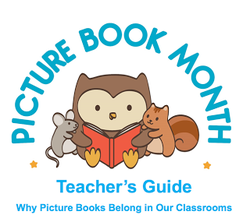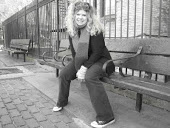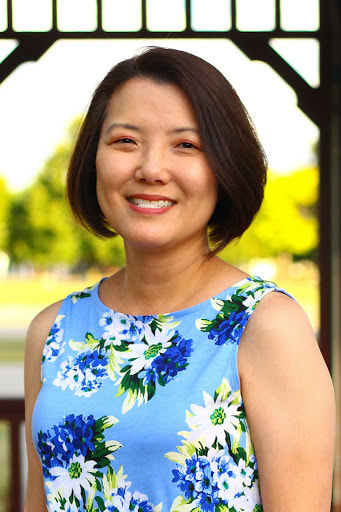 Welcome Marcie Colleen, Education Consultant for Picture Book Month! Marcie wrote an awesome picture book guide for teachers to use as they plan lessons and activities using picture books in the classroom. Both parents and teachers should check it out. Picture books have a special place in my heart, which is why I'm trying to write them. And along the way, I've met the fabulous Marcie online in kid-lit circles. She also writes picture books. Below are some questions for our educational consultant. 1. How did you come up with the idea of writing teacher guides for picture books? Do most publishers not provide these services as a marketing tool? In my former career as a theater educator I created a lot of curriculum guides. I loved the research that came with working on a guide and once I started working in NYC on Broadway shows, I loved the challenge of connecting academic subjects to seemingly frivolous Broadway musicals. So when I started my new career as a picture book writer I started exploring whether or not there was a need for such curriculum guides for picture books. Yes, some publishers do provide teacher’s materials for use as marketing tools. However, these are mostly highly designed one pagers. My guides are usually around 16 pages and delve into ELA, Math, Science and Social Studies activities. They provide a more in-depth, thorough study of the book, and offer many avenues to approach bringing a specific book into the classroom. My guides have been regarded quite nicely by classroom teachers. 2. In your interview on Brain Burps about Books regarding your teacher guide for Picture Book Month, you said you didn't write activities to any specific books. Can you elaborate on that for my readers? Yes. Many of the books on the market that speak to using picture books in the classroom provide book specific lessons. When I set out to create the Picture Book Month Teacher’s Guide, I wanted to provide teachers with a guide. I didn’t want to dictate what titles are good for the classroom. Instead I wanted to provide a blueprint to be used for any picture book. I knew that if I mentioned 5 titles in the Math section that could be used in a Math class, those 5 books would be used in a Math class. However, I wanted to inspire a teacher to use this guide and its activities as a springboard to introduce their own favorite titles or the favorites of their students. I stand firmly behind my statement that ANY picture book can be used in the classroom. 3. Do you think there is enough diversity in picture books? And do you think diverse picture books should be shelved together, or should they be regarded as just a normal picture book that encompasses American culture? I recently attended an editor panel discussion and diversity in picture books was definitely a hot topic. I think there are two sides here that are equally important. Yes, I think there is a need for more multicultural stories. Stories about many different cultures: their customs, their history. But that to me is not where the diversity is most needed. Diversity is not necessarily multiculturalism in this respect. What is definitely needed is more diversity in depicted characters. It would be nice to see characters of color that are not about their color. Know what I mean? Like that SNOWY DAY by Ezra Jack Keats. It is an everyday story that happens to have a little African American boy as its protagonist. No way would it be considered necessary that SNOWY DAY be shelved with the “multicultural books”. We need illustrators to spearhead this. Let the African American child see themselves in the princess tale, or the Asian child see themselves in the space adventure. Let’s ban together to bring diversity without pigeon-holing the story topics. 4. I know nonfiction is getting all the attention right now because of the Common Core Standards; however, I've read and worked with the standards for educational publishers. There are standards for fiction stories, too. So why do you think so much attention is on nonfiction? The Common Core State Standards are for both nonfiction (Informational texts) and fiction (Literature). But there does seem to be an emphasis on nonfiction texts right now. The reason is that up until now a lot of nonfiction for the classroom was very dry and encyclopedic. Therefore, teachers are asking for more engaging and compelling nonfiction. This does not mean that teachers are not using fiction in the classroom, it’s just that fiction has been of a high quality for some time now. It’s the nonfiction that needs a shot in the arm. 5. What were your favorite picture books as a kid? What are some of your favorite picture books as an adult? My absolute favorites as a kid were the Curious George stories and CAPS FOR SALE by Esphyr Slobodkina. I guess it’s no surprise that I grew up to be a mom of a sock monkey, right? I also loved Frances from the Russell Hoban stories. Today I am a fan of Oliver Jeffers’ work. I also really enjoy the Emily Brown stories from Cressida Cowell. I am drawn to stories that are quirky but with a tender emotional truth. Thanks so much, Marcie, for answering my questions and making picture book month special to teachers, children, and writers! You can check out the other posts on this blog hop here: Thurs Nov 7 Lauri Meyers Mon Nov 11 Jean Reidy Wed Nov 13 Darshana Khiani Wed Nov 20 Joanne Roberts Wed Dec 4 Julie Hedlund  Bio: Marcie Colleen, Picture Book Month’s Education Consultant, has been in education for 18 years. She is a former New York classroom teacher and has served as a curriculum creator for the Central New York Institute of Aesthetic Education, Syracuse Stage, Tony Randall’s National Actors Theater, and various Broadway and Off-Broadway shows. She was the Director of Education for TADA! Youth Theater in NYC creating and managing educational programming reaching over 30,000 students and families in the NYC Metro area a year. Her Teacher’s Guides for picture books and middle grade novels can be found at www.thisismarciecolleen.com.
24 Comments
11/25/2013 03:36:59 am
Yay for 'Caps for Sale' and the 'Frances' books...we must be related somewhere, Marcie! I loved what you said about the need for diversity in picture books...children of all cultures should be found doing all types of activities in a story...not because they are from a particular race or ethnic background, but just because they are...children. :)
Reply
12/9/2013 10:24:03 pm
If we are ever to learn to treat people as people, and not as their race, we need to start seeing people of color EVERYWHERE!
Reply
Pam Brunskill
11/25/2013 04:41:13 am
Great interview, Tina! I always enjoy hearing what Marcie has to say :)
Reply
12/9/2013 10:24:49 pm
Thanks, Pam. We have met a few times and its always a pleasure. :) 11/25/2013 09:03:18 am
Good to know, Marcie, that the need for non-fiction PBs are on the rise, since that is my passion. Thanks for sharing!
Reply
Marcie Colleen
12/9/2013 10:25:37 pm
Totally, Jarm! Its time to give NF and Fiction equal due!
Reply
11/25/2013 10:26:45 am
Thanks for an enlightening interview. You asked several questions that have been on my mind. Thanks too to Marcie for sharing her experience.
Reply
Marcie Colleen
12/9/2013 10:26:17 pm
Tina did have excellent questions. :)
Reply
11/25/2013 11:39:01 am
Fabulous interview of Marcie! I think it was brilliant to not mention specific books in her educational guide so that it can be applied to any and all books. And I love her example of The Snowy Day as a way to bring diversity into stories without making it a big deal.
Reply
Marcie Colleen
12/9/2013 10:27:09 pm
Thanks, Teresa. I am glad you have found the educational guide helpful.
Reply
11/26/2013 05:20:59 am
Tina and Marcie, thanks for the informative post. I'll definitely be saving this one.
Reply
Marcie Colleen
12/9/2013 10:27:43 pm
Excellent! Thank you! It is an honor to be "saved".
Reply
Leave a Reply. |
Tina M. Cho, children's authorI'm a children's author and freelance writer for the educational market. Welcome! Archives
March 2024
Categories
All
|




 RSS Feed
RSS Feed
